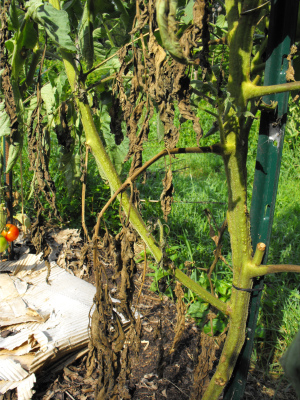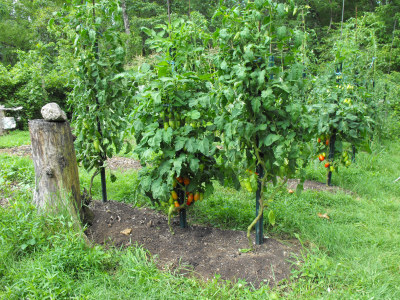
Dealing with the first signs of tomato blight
 But
what do you do if, despite preventative pruning, your tomatoes begin to
show signs of late blight?
Rather than sticking your head in the sand the way we did last year,
your best bet is to take decisive action immediately. Single out
any tomatoes on which the blight has progressed beyond the very lowest
leaves and delete the entire plant. Then clip off any blighted
lower leaves on nearby plants.
But
what do you do if, despite preventative pruning, your tomatoes begin to
show signs of late blight?
Rather than sticking your head in the sand the way we did last year,
your best bet is to take decisive action immediately. Single out
any tomatoes on which the blight has progressed beyond the very lowest
leaves and delete the entire plant. Then clip off any blighted
lower leaves on nearby plants.
During this extensive
pruning expedition, you should wipe your clippers with a rag soaked in
alcohol every time you move from one plant to another, or from a more
blighted area to a less blighted area. In addition, you shouldn't
even think about going into a blighted tomato patch when dew or rain
are heavy on the plants --- blight spores move around and germinate on
wet surfaces.
 This
is also the one time I advocate removing biomass from the farm.
You should definitely not incorporate the blighted tomato residue into
your compost pile, but I feel that it's dicey to even toss it off into
the bushes at the edge of the woods. Instead, I actually let Mark
haul our blighted tomato parts away to the dump.
This
is also the one time I advocate removing biomass from the farm.
You should definitely not incorporate the blighted tomato residue into
your compost pile, but I feel that it's dicey to even toss it off into
the bushes at the edge of the woods. Instead, I actually let Mark
haul our blighted tomato parts away to the dump.
Finally, I take the
first sign of blight as a signal to get realistic. All of your
hard work pruning off diseased foliage is not going to cure your tomato
patch of the blight --- it will merely slowly the disease's
spread. You might be able to stay ahead of the blight for a while
by removing any yellow or brown leaves, but you'll have to stay
vigilant. So harvest while you can!
| This post is part of our Organic Tomato Blight Control lunchtime
series.
Read all of the entries: |
Want more in-depth information? Browse through our books.
Or explore more posts by date or by subject.
About us: Anna Hess and Mark Hamilton spent over a decade living self-sufficiently in the mountains of Virginia before moving north to start over from scratch in the foothills of Ohio. They've experimented with permaculture, no-till gardening, trailersteading, home-based microbusinesses and much more, writing about their adventures in both blogs and books.
Want to be notified when new comments are posted on this page? Click on the RSS button after you add a comment to subscribe to the comment feed, or simply check the box beside "email replies to me" while writing your comment.

Anna,
Can/will you do an article on battling spider mites on tomatoes?